Glenn Falla is so passionate about ducks that even his phone quacks.
We are crouched in a boat on Reedy Lake – part of a game reserve south-east of Geelong – when the hunter’s mobile starts squawking like one of the Pacific black ducks he is here to hunt.
Even in the silvery dawn Falla can identify bird species by their wing spans and flight patterns.
“There’s a pied cormorant,” he says, pointing at a black and white bird skimming over the mirrored water surface. “That one’s a protected species.”
Falla grew up hunting ducks on his family farm in Donald in central Victoria. “From the age of four or five I was carted in by my father, quite often on his shoulders,” he says.
Now Falla hunts his own food with his 86-year-old father and 22-year-old daughter. “It’s been a long-standing tradition in our family.”
For decades, hunters and animal welfare activists in Victoria have been locked in a bitter and polarising battle over whether native game bird hunting is a sustainable way of killing your own food or a barbaric blood sport.
Falla believes hunters rarely get to tell their side of the story, which is why he’s agreed to take us out this morning.
“We’ve got these activists in kayaks harassing us, hindering us,” Falla says. “They say ‘Oh, gee, you’ve got a big long gun there. It must be because you’ve got a small penis’.”
Growing up on a farm taught Falla there’s no nice way to die. “If you eat meat there is a degree of cruelty – the animal has died,” he says.
“Is duck shooting more or less cruel than an animal that’s bred for the table and taken to an abattoir and stood in line and listened to all of its friends in front of it being killed?”
It’s a rhetorical question revisited every year when the government grapples with whether to declare a duck hunting season; a fraught period of contested claims around animal welfare, conservation and hunting traditions.
Under threat
The sun is rising over Reedy Lake, turning the clouds flamingo pink and gilding the reeds.
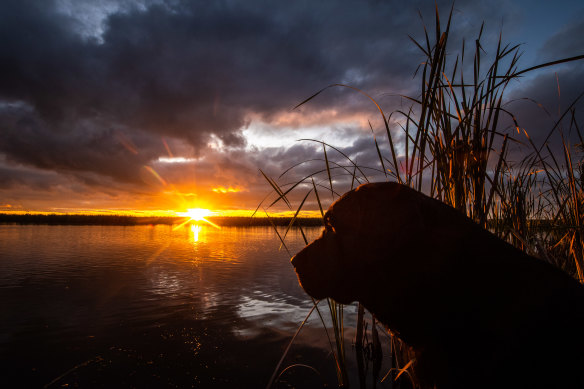
Finn, the labrador retriever, watches the sun rise over Reedy Lake.Credit: Justin McManus
The lake – which is listed under the Ramsar Convention as a wetland of international significance – is home to a wide variety of waterbird species.
It was here, in 1986, that veteran anti-duck hunting campaigner Laurie Levy first faced around 8000 hunters and formed a team to recover wounded birds.
In the intervening years there has been a shift in sentiment against duck hunting. A poll conducted for the RSPCA between April 2022 and April 2023 found 68 per cent of metropolitan residents and 60 per cent of regional Victorians opposed it.
Victoria has historically been reluctant to outlaw duck hunting, despite it being banned in Western Australia, NSW and Queensland.
But this year the government announced a shortened season ending on May 30 and more restrictions, citing concerns about the wounding of ducks, poor behaviour by some hunters and long-term decline in waterbird numbers.
A week after our hunt, the duck hunting season at Lake Connewarre state game reserve – which includes Reedy Lake – was cut short to ensure the safe release of captive-bred critically endangered orange-bellied parrots.
And a parliamentary inquiry – due to report at the end of August – will examine the future of recreational native bird hunting.
For hunters in Victoria, duck hunting is facing one of its greatest challenges ever.
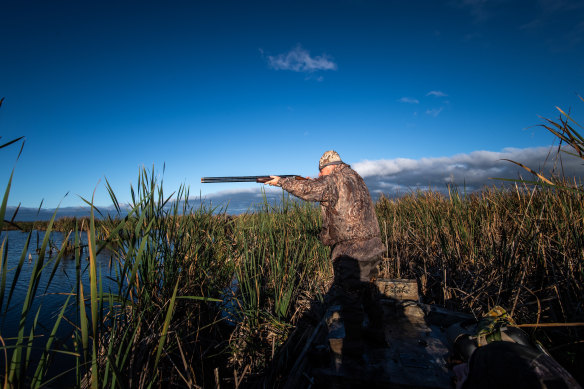
‘If you eat meat there is a degree of cruelty’: Falla takes aim.Credit: Justin McManus
In the law’s sights
It’s a bluebird day – sunny and clear – which is good news for ducks, who like to bask in the centre of the lake, but not for hunters, who prefer blustery conditions that drive birds to shelter in the reeds.
Ducks also have excellent eyesight and the sun glinting off the water turns it into a mirror, making it trickier for hunters to hide their faces and guns.
The start time for the Victorian duck hunting season is 8am this year and Falla has put an alarm on his phone to ensure he doesn’t take a shot a minute too soon.
The half-hour before sunrise when ducks wake up and start moving around the freshwater swamp is the ideal time for hunting and the later start rankles Falla.
Loading
Field and Game Australia – the nation’s premier hunting organisation – describes it as an “egregious abuse of power by a minister”.
But it stresses that 8am is the law and – like the daily limit of four birds that each hunter can harvest and recent prohibition on hunting Blue-winged Shoveler and Hardhead ducks – must be obeyed.
“I won’t even put a cartridge in my firearm until it’s the legal time because then you can’t be tempted to do the wrong thing,” says Falla, who is the conservation and hunting manager at Field and Game Australia. He also works as a tour guide, taking people from all over the world waterfowl hunting.
Field and Game Australia assures its 15,000 members it’s working hard to secure the future of hunting for years to come. It urges them to do everything they can not to give “the antis” – as they call animal welfare activists – ammunition for their campaign.
Don’t windmill birds (swing a wounded bird by the neck in a circle to kill it), it warns in a newsletter. “There are other ways to dispatch a bird that are just as easy but don’t give the antis such provocative footage.”
Immediately dispatch all birds: “If in doubt – shoot it again!” Be aware that cameras are everywhere. Make a submission to the parliamentary inquiry. Be an ambassador for hunting.
‘We want them to come close’
It’s 7.47am. We are hiding behind a clump of metre-high reeds wearing camouflage balaclava face masks while Falla scatters realistic plastic duck decoys.
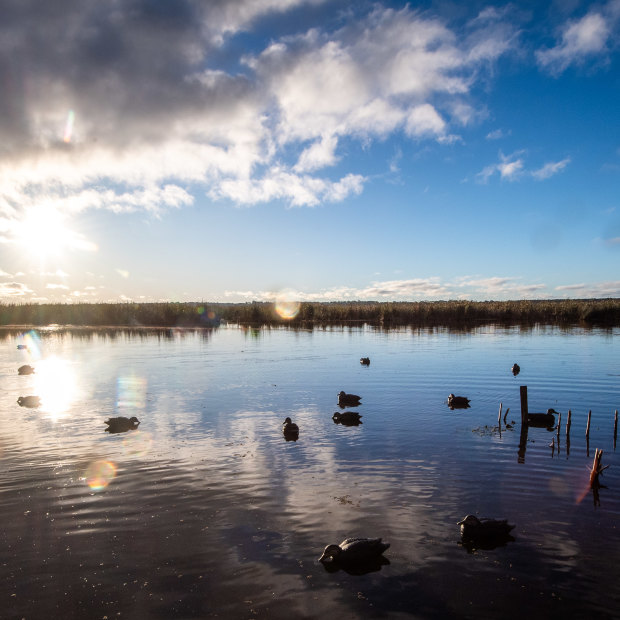
Plastic decoy ducks that the hunters place on the water to attract wild ducks.Credit: Justin McManus
One decoy has its bum in the air, another is battery-operated, its spinning wing splashing the water, which is particularly useful for luring wild ducks on a still day.
“We want them to come close, so we can be sure we get a clean shot rather than ‘spray and pray’,” Falla says.
Finally Falla’s alarm goes off. We are hushed, told to crouch down.
Dave Smeaton, a hunter from Clunes in a neighbouring boat, sounds a duck caller which emulates the long quack of a Pacific Black duck.
There’s an art to duck calling and Smeaton can mimic several species, from the voot voot of a Pacific black to the continuous gack gack gack gack of a grey teal.
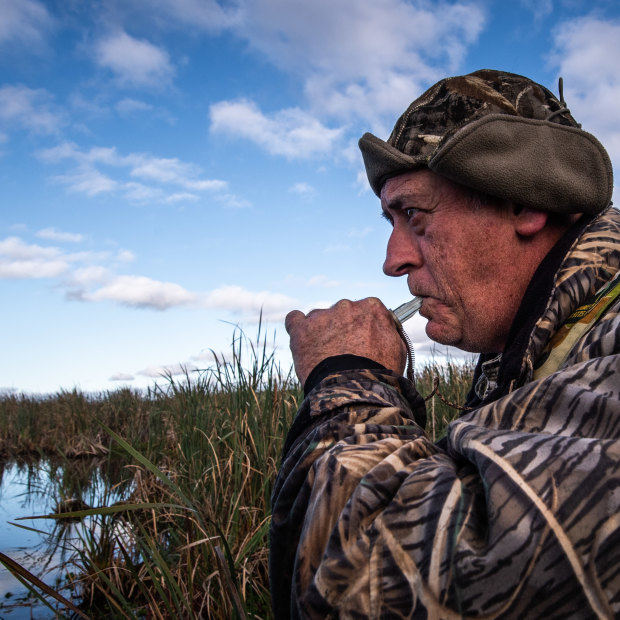
Duck hunter Dave Smeaton using his caller to lure ducks in.Credit: Justin McManus
There’s an unearthly quiet and then the crack of a gunshot crumples the silence. A Pacific black duck falls out of the sky. It hits the water but is still alive and flapping towards the reeds. “Back it up Dave!” Falla yells.
There is a volley of six or seven shots and finally the bird is still. “Send the dog,” Falla shouts, and Finn, a labrador retriever, jumps off Smeaton’s boat and swims towards the duck, returning with its neck loosely flopping in his mouth.
“That’s a great example of where things didn’t go perfectly,” Falla says.
“What I would have preferred was one shot and it fell completely dead in the water. But you can see that we’ve done everything we possibly could to make sure that we’ve dispatched the bird as quickly as we could. That bird was dead within a couple of minutes. I would think that duck has lived a better life than a pig that’s been standing in line at the abattoirs all day.”
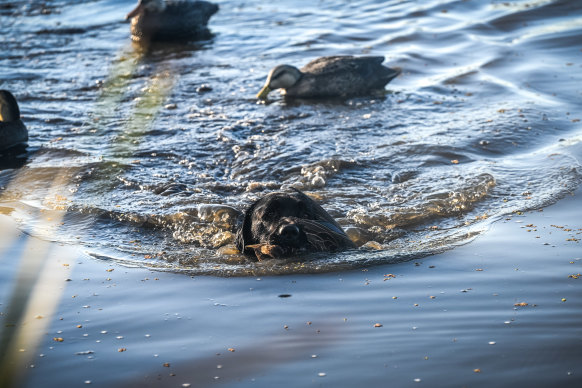
Finn, a labrador retriever, carries a dead duck back to the boat.Credit: Justin McManus
The wounding of ducks is one of the major criticisms levelled at duck hunting. Shotguns spray tiny steel balls over an area and there can be insufficient pellets to kill a duck.
By law, hunters must make every reasonable effort to immediately retrieve game birds after they are shot and salvage at least the breast meat.
But every year injured ducks escape into dense reeds, and while hunters often use dogs to retrieve them, others are not found or abandoned.
The RSPCA says many of these will suffer a slow, painful death due to starvation, being eaten by predators, infection or exposure.
Earlier this month animal welfare activists laid 73 dead birds outside Premier Daniel Andrews’ office at 1 Treasury Place.
The birds had been found by activists during the first five days of the hunting season and taken to a veterinary triage tent staffed by Wildlife Victoria at Wooroonook Lakes, near Charlton in northern Victoria.
“Twenty-two of those birds were still alive. Their injuries were so horrific, our vets had no choice but to euthanise them,” says Wildlife Victoria’s chief executive Lisa Palma.
Palma says the other birds had been found dead, the majority with shotgun pellets in their bodies.
The Game Management Authority – an independent body which regulates game hunting in Victoria – monitors trends in waterfowl wounding.
In 2022, a total of 596 ducks were captured and X-rayed. Of these, 3.4 per cent (20 ducks) were found with embedded pellets.
“All stakeholders acknowledge the need to reduce wounding rates from duck and stubble quail hunting,” a Game Management Authority spokesman said.
Of the 72 birds found in the first five days of this year’s season, eight were threatened species including blue-winged shovelers, hardheads and a freckled duck, one of Australia’s rarest waterbirds.
Falla acknowledges that sometimes protected species are caught in the spray of pellets. “We’re continually educating our members to be aware not only of the bird you’re shooting at but what’s in the background.”
He picks out a duck at the back of a flock, which means the other birds fly away unharmed.
This time the duck is dead after one shot. “That’s the way we like to do it. One shot, bang, lights out, gone, on the water, didn’t even know about it. It was flying and then it was not.”
The “ethical distance” to shoot a duck is within 30 metres, Falla says, which means the shot is much more likely to be lethal. “It’s a fallacy to say that hundreds of pellets are wounding other birds every time we pull the trigger.”
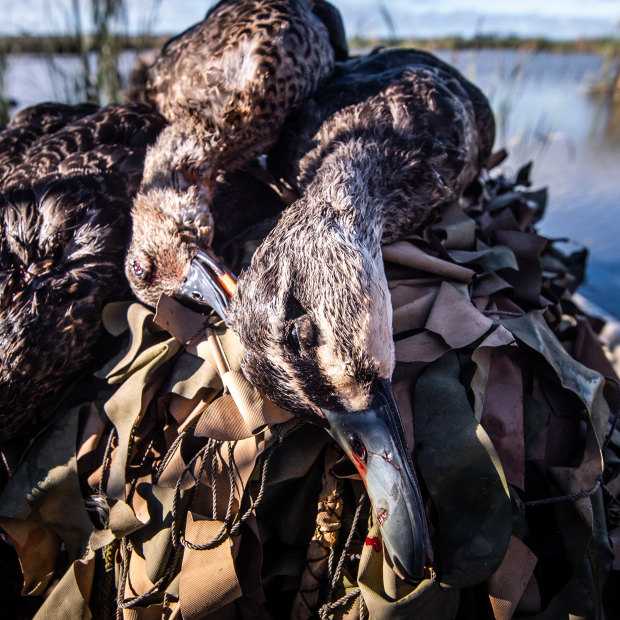
The hunters bagged three ducks for the day. The legal limit is four ducks per hunter a day.Credit: Justin McManus
But of course not every hunter is ethical. During the 2022 duck hunting season the Game Management Authority found 38 breaches of hunting and public safety laws.
These included hunting without a game licence, entering a wetland without authorisation, littering, possession of toxic shot and exceeding the daily limit of ducks that can be hunted.
The Sunday before we go out with Falla, his hunt was interrupted by wildlife rescue volunteers in kayaks. Sometimes they race to pick up wounded birds before hunters or their dogs can get to them, he says, and then take them to triage tents where they are often euthanised anyway.
Falla says rescue volunteers deliberately paddle around decoys to scare birds away. “If they were protesting in the car park or at the front gate, we wouldn’t have a problem with it. But they place themselves in danger all the time.”
In 2011 a wildlife rescue volunteer was shot in the face at Lake Buloke, near Donald, when a shotgun pellet ricocheted off the water.
“They just paddle around out there as if there’s no fear,” Falla says. “They’re pretty brave or not very intelligent, one of the two. I wouldn’t do it. It’s crazy.”
The sun has risen over the water and the early flurry of activity has been replaced by a long lull. We already have three ducks – two Pacific blacks and a grey teal – and call it a day.
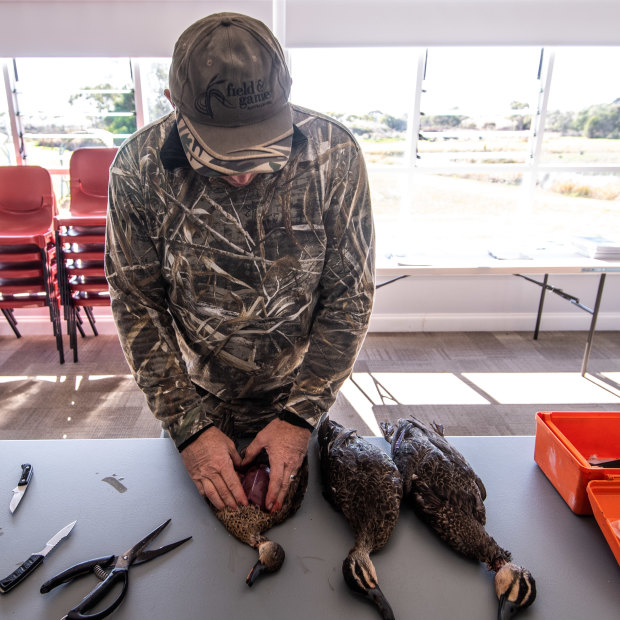
Hunter Trent Leen prepares the ducks for eating after the hunt.Credit: Justin McManus
Back at the Connewarre Wetland Centre, Trent Leen, the conservation officer of Geelong Field and Game, deftly plucks the ducks, revealing shiny dark pink breast meat.
The centre looks onto a wetland with trees planted by Geelong Field and Game members.
It was Leen’s father, Tony, also a keen hunter, who bought this land in the 1980s because he was concerned wetlands were being drained for farmland or used for landfill.
Tony, who ran a demolition business in Geelong, made the wetland using his own earth-moving equipment. This year he was awarded with a medal of the Order of Australia for his service to conservation and the environment.
“We pushed up some islands to provide a safe habitat for nesting birds because the ducks nest on the ground and were being hunted by foxes,” Leen says.
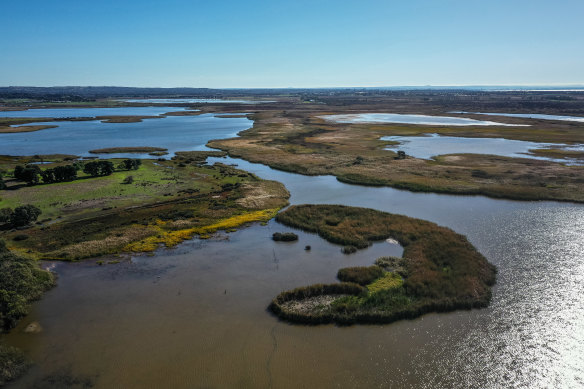
The state game reserve wetlands at Lake Connewarre on the Bellarine Peninsula.Credit: Justin McManus
Today the wetland, maintained by Geelong Field and Game, attracts a myriad of waterfowl and other species including brolgas, magpie geese and Cape Barren geese.
It’s used by Deakin University, which swabs birds as part of its research into avian influenza, by Field and Game Australia, which researches the use of nesting boxes to regenerate duck populations, and by school groups and birdwatching clubs.
Danny Ryan, a fourth-generation duck and quail hunter from Bendigo and chair of Field and Game Australia, says there’s no one more connected to the land than a hunter.
“We put into conservation and land rehabilitation,” he says. “We understand the seasons, the game we hunt, the conditions of the land, the periods of boom and bust, the need for conservation and protection of habitat.”
Ducks in decline
There’s been a long-term decline in the number of waterbirds in eastern Australia, which animal welfare advocates argue is another reason hunting should cease.
Last year’s annual survey of Victoria’s game ducks showed an estimated population of 2.4 million – down from 2.9 million the previous year.
However, it points out lower estimates could be a result of heavy rainfall creating alternative habitats – such as flooded paddocks – both in Victoria and interstate, which attracted ducks but were not surveyed.
Conservation biologist Professor Richard Kingsford, who directs the Centre for Ecosystem Science at the University of NSW, expects a bounce in numbers this year due to increased breeding over two wet years and ducks returning to the waterways included in the survey.
What is the impact of hunting on duck populations?
Kingsford, who has been conducting yearly surveys of waterbird numbers across eastern Australia for 40 years, says his research showed hunting had a small negative impact.
“But it was a lot smaller than the effect of the loss of habitat,” he says.
“Over the last 40 years we have lost a lot of waterbird habitat due to the building of dams and diversion of water for irrigation and development of flood plains.”
The smell of cooking prosciutto is wafting through the Connewarre Wetland Centre.
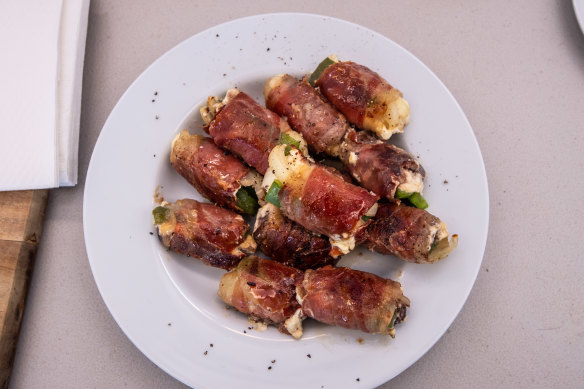
‘It’s very versatile, you can do just about anything with it’: duck poppers prepared by hunter Glenn Falla.Credit: Justin McManus
Falla is making duck poppers; an appetiser of duck breast, cream cheese and capsicum wrapped in prosciutto marinated in maple syrup. “They go pretty quickly.”
Falla also makes duck schnitzel, duck curries, duck risottos and slow-cooked duck casseroles.
“It’s very versatile, you can do just about anything with it, it’s low in fat, it’s really healthy.”
But the thing he most likes about hunting is the connection to the bird.
“It’s not about killing things,” he says. “You’ve actually got to connect with that bird – talk to it and talk it in and convince that bird that these plastic ducks that are in front of us are real birds and that they want to join that mob of ducks. So it’s that personal connection. And being out here in a beautiful wetland like this in the morning. Where else would you want to be?”
The side benefit of all this, Falla says, is he gets to take some free-range meat home. “I just don’t see anything wrong with that.”
The Morning Edition newsletter is our guide to the day’s most important and interesting stories, analysis and insights. Sign up here.
